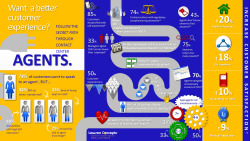
But just like an actual road trip, all sorts of issues occur along the way. You might get a flat tire or run out of gas. An accident or road construction might cause delays or even detours. And efforts to compensate for lost time could earn you a speeding ticket and an onerous lecture from a highway patrolman.
A military strategist once said, “No battle plan survives contact with the enemy because the most brilliant plan loses touch with reality.” It’s the same with the customer experience.
There’s a specter that haunts agent-customer phone interactions and makes mayhem of your plans, communications and training, regardless of budget. It’s called: the AGENT experience. It’s where the rubber of your plans meets the road of reality. And all your efforts to bolster customer satisfaction are for naught if it’s not part of your customer strategy.
So what’s really happening?
Think about the last time a contact center agent placed you, as a customer, on hold. The agent may have said something like, “I’m placing you on a hold for a moment while I look at your account.” Sound familiar? What was the agent doing during that hold? Most likely searching for a document to understand the next step in the process or how to handle the transaction with the available applications.
Studies show that putting customers on hold is what really tanks customer satisfaction scores, which may mean your journey is already behind schedule in the first 60 seconds of the trip. In all likelihood, those legacy applications agents use are not integrated. After searching, agents are forced to cut, copy and paste data or, worse yet, ask the customer to repeat information.
Because of the spaghetti path you force agents to wade through, you could experience a decrease in customer satisfaction of more than 20 percent. And it’s the agent’s experience that becomes the REAL customer experience, no matter how perfect your plan.
Agents already spend 14 percent of their time searching for documents to resolve customer issues, and you can expect the corporate information they must sift through to double every 3.5 years. For a 1,000 seat contact center paying an average agent wage of $10 an hour that equates to a more than $4 million annual inefficiency.
As you add documents and change them – something which happens in most contact centers daily – agents must try to memorize more and more locations. They search shared network drives, web sites, help systems, SharePoint sites, emails and more. When (if!) they find the right spot, they must then search within it for the right document and skim its content to determine if it holds the answer they need. If not, it’s back to square one. This process may repeat again and again, all while the customer is on hold.
Guided navigation solutions are fundamental to reeling in your information resources by creating a single point of truth that can quickly assist agents at the right moment during customer interactions. Their context sensitive help features eliminate document searching, which allows the agent to focus on the customer instead of documents.
Help! I’m Drowning in Information
Many organizations have been drowning in information resources for so long they don’t know where to begin digging out. Lawson Concepts offers an impact analysis discovery to bring to light how information resources impact your organization and, more importantly, your customers.
By studying the various touch points of information flow, we uncover its impact on agents and look for opportunities to improve its flow. You’ll begin to understand how contact center and back-office agents come up with answers—what they go through and whether, indeed, the answers are what they should be. As an objective third party, we can side-step organizational barriers that many times blur symptoms as well as root causes.
Transforming how agents interact with applications and accessing information makes for a better customer experience. You’ll reduce operational costs, increase agent morale and decrease agent fatigue. And all that will make customers happier, too.
About the author: Chris Lawson is Managing Partner at Lawson Concepts and a regular contributor to the NICE blog. Contact Chris directly to request a free copy of their Infographic “The Secret Path of Agents” or for more information about an Impact Analysis Discovery.




